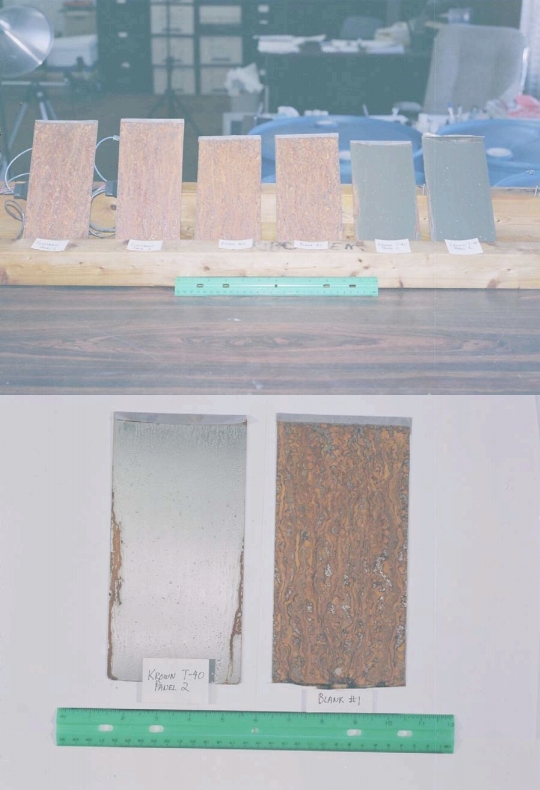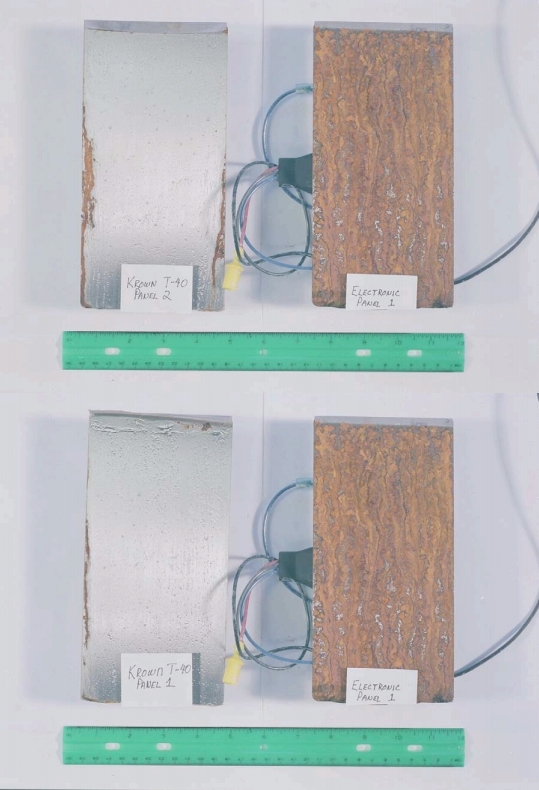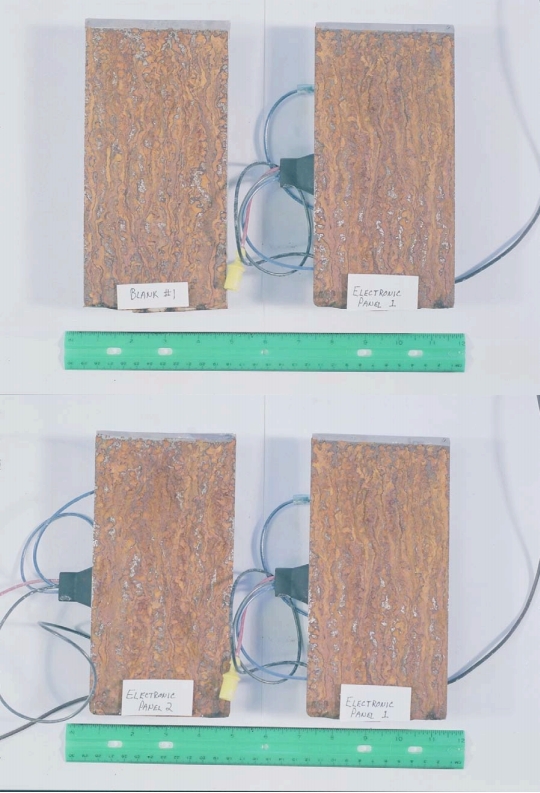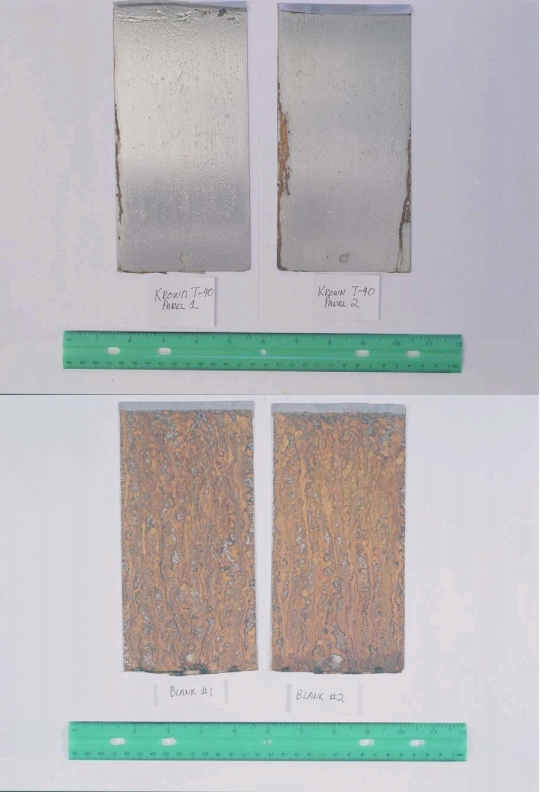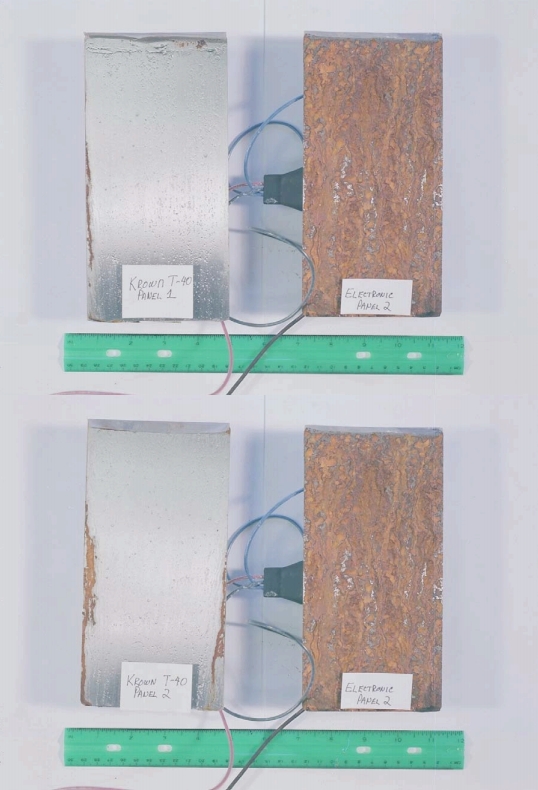Do electronic rust protectors work?

Here is a study we came across to answer that very question.
“COMPARATIVE TESTING OF ELECTRONIC MODULES FOR RUST PROTECTION”
By Vincent J. Curtis, M.Sc. CD , President , Tribochem, Inc.
INTRODUCTION
The object of this set of tests was to evaluate the ability of electronic rust protection
devices to protect steel Q-panels from rusting in a salt spray cabinet. These electronic
devices are sold commercially and are claimed to be able to protect an automobile from
rusting when installed. The manufacturers of these devices offer laboratory test results in
of support the inference that the devices work in “real world” practice.
METHOD
Three pairs of Q-panels were tested at an independent laboratory in a salt spray cabinet
operated in accordance with ASTM D-117.
One pair of Q-panels were blanks, that is they were not protected in any way from rusting
in the conditions of the cabinet.
Another pair was coated with Krown T-40 product at the Tribochem plant in Cambridge,
ON. These panels were left to stand in the ambient atmosphere for five days before the
test was begun at the independent laboratory that operated a salt spray cabinet. The limit
of Tribochem’s involvement in the preparation of the test Q-panels was the preparation of
the panels coated with Krown.
A third pair was protected by a pair of commercially sold electronic devices. Two
electronic modules “Counter Act Electronic Rust Prevention” units (serial numbers
105645 and 105742) were provided by Krown Corporate in their sealed original boxes to
Tribochem. Each device was connected to its own separate Q-panel at the independent
laboratory. The two devices were powered by an automobile battery located outside of
the cabinet, and the battery was, in turn, kept fully charged by a tickle charger. The
protection electrodes of the devices were connected to either end of their respective 4” X
8” Q-panels.
Prior to the start of the test, the electronic devices were switched on and off to confirm
that the red lights on the devices flashed and that the devices were operating normally.
The three pairs of Q-panels were placed in the cabinet and subjected to 48 hours of the
conditions. After 24 hours, the panels were checked, and it was confirmed that the lights
on the devices were still flashing.
RESULTS AND DISCUSSION
Photographs of the panels after the completion of the test are included elsewhere in this
report.
As expected, the panels protected by Krown T-40 showed very little rusting. Some run-
down from the sides of the panel was observed, but otherwise the face of the panel was
shiny and free of rust. The tape that covered the side and top edges of the test panel had
pulled way during the second day of the test, and that is where rusting originated.
The blank Q-panels were, as expected, thoroughly rusted. The faces of both panels were
entirely covered in rust.
The Q-panels protected by the electronic devices were indistinguishable from the blank
panels. The faces of both panels protected by the electronic devices were entirely
covered in rust.
These results undercut the inference offered by the devices’ manufacturer that laboratory
tests demonstrate real-world rust protection when the device is properly installed in an
automobile. Whatever the details of the alleged ‘protective’ mechanism might be, the
device is supposed to protect the car body lying in the field created by the device between
the two protective electrodes. That is the theory. The field created by the device in a
small Q-panel is much more intense than any in a car body in which the device was
properly installed. More rust protection is to be expected from a more intense field. Yet,
the devices were unable to protect a Q-panel in a salt-spray cabinet at all, for there was no
difference in appearance between them and the unprotected blank panels. The Krown
panels, on the other hand, were well protected compared with the blanks.
In previous reports on this subject, I allowed that these electronic devices might work in a
laboratory even though they would not work in a real world situation. Over twenty years
ago, devices like these were advertised as working on the principle of cathodic
protection. Now, cathodic protection is a well-known means of protecting large objects
such as ships and pipelines from rusting, and it was certainly possible to contrive a lab
test which demonstrated the principle of cathodic protection by a small device. However,
these cathodic protection devices failed in the real world because the special conditions
of the lab test did not obtain in a car operating in the real world. The car was not
continually bathed in salt water as a ship was and as the Q-panel was in a salt spray
cabinet. Devices based on cathodic protection were discredited.
These new devices were claimed to work, not by the well-known principle of cathodic
protection, but by some patented method new to the science of corrosion. Contrary to
what the manufacturer claims, when installed in an automobile according to instructions
these electronic devices do operate on the principle of cathodic protection.
Here’s why. Regardless of the details of the internal operation of the device, it is claimed
in principle that the device is a means of converting electric power into the protection of
steel from rusting. When installed in an automobile according to instructions, the electric
power that operates the device comes from the car’s battery. When discharging, a lead-
acid battery creates electric current from the oxidation of the metallic lead that forms the
anode of the battery. Now, oxidation is a form of corrosion, hence the principle of the
device is to convert the corrosion of the lead anode into rust protection. This is a kind of
cathodic protection because the corrosion of the battery anode is supposed to protect the
steel of the car from corrosion.
Because of what I knew of the cathodic protection devices, I allowed that it might be
possible to contrive a lab test in which these new “electronic” devices actually worked. It
would be risky of the manufacturer to make a claim of favorable lab results and not have
anything at all that could be reproduced independently.
Nevertheless, I remained deeply skeptical that the devices worked in the real world based
on: the description of the alleged operating mechanism in the advertising literature, upon
the wiring diagram, upon the limited power and small size of the device, and upon the
claim that the patented method was new to science.
On the basis of these lab tests, I granted the devices more credit than they were due.
These devices do not appear to work at all, even in a favorable laboratory environment.
CONCLUSIONS
1. The “Counter Act Electronic Rust Protection” device does not work. It did not
prove out in the laboratory, where the conditions for its successful operation were most
favorable. It will most certainly not work in the real world.
2. When powered from a car battery, the principle of operation of the device is a
kind of cathodic protection, a method which was discredited over twenty years ago.
2. Krown T-40 dramatically out-performed the device in terms of rust protection
under the conditions of the test.
Contact us for more information today.
